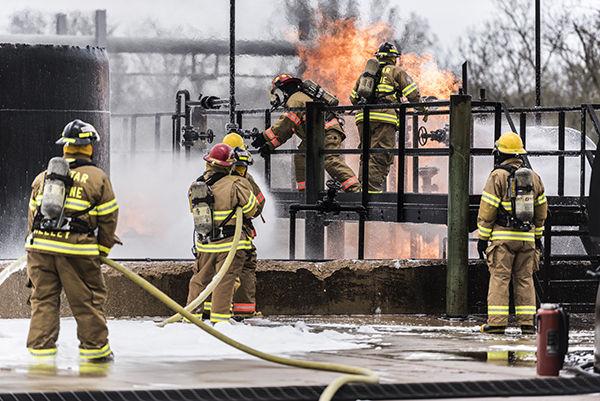The students hold the 200-pound hose as the fuel technician opens the valve, feeding the fire in the metal skeleton of a structure before them. The leader signals, the students move forward in unison — the simulation begins.
This scenario is just one of many hands-on training experiences faced by firefighter students at one of the largest fire training facilities in the world, just 10 minutes from campus.
Referred to as the “Disneyland of fire and rescue,” the Texas A&M Engineering Extension Service Brayton Fire Field contains 80 burn props, rigs and gutted buildings that can simulate any disaster situation and offers two fire schools during the year, one in the March and the other in July. While the spring classes are smaller, roughly 500 students from across the globe come to College Station to receive first-response training.
Brian Scheffer, a captain with the Brenham Fire department, is in his 11th year as a guest instructor for the spring fire school.
“Being in Texas, we do everything bigger and badder than everybody else, and in my opinion it’s a great honor to have this school here,” Scheffer said.
Mike Wisby, associate division director for the Emergency Services Training Institute, which operates Brayton, said the school was established in 1930 with 196 students from 76 Texas cities and towns. Today the school sees 45,000 students per year from across the globe. There are also satellite stations throughout the world, bumping the total number of people trained by TEEX to 80,000 annually.
Wisby said TEEX, which includes the fire school along with specialized first response, has taught first responders who helped civilians in events like the Bastrop fires, Boston Marathon bombing and the London subway bombings.
While not the largest in the world by size, Wisby said the university-based fire field is the largest in amount of equipment. The rigs, called props, focus on both municipal, including home and commercial businesses and industrial fires.
Safety and teamwork are highly stressed. Wisby said multiple instructors watch from the sidelines during a simulation, ready to step in if something looks off about the simulation. The students learn to communicate either through hand signals or verbal cues.
“They’re having to learn how to work as a team,” Wisby said. “They have to learn how to move. We call it, ‘Teaching you how to dance.’”
Scheffer said safety is highly stressed in his classes.
“The number one priority in all incidents — whether it’s hazmat, fire, wreck — is life safety and it starts with your safety first and we want to make sure you do your job as safely as possible,” Scheffer said.
To run the fire school, Wisby said facilitators pump more than a million gallons of water per day. However, the water is drained into storage tanks to be recycled and reused. Most of the fuel used is E3, and the fire school uses about a million gallons per year of the flammable liquid fuel.
“That fuel is blended for us by ConocoPhillips in Borger, Texas, up in the Panhandle,” Wisby said. “They will tank truck that to us, we use it in the tanks and that’s what we use out here. You get a really good fire, just like gasoline or diesel burning, but you don’t get the smoke. It’s a low-smoke fuel developed just for us.”
Scheffer said TEEX has both industrial or municipal props.
“The industrial props are extremely realistic,” Scheffer said. “Those are probably the most realistic industrial burning props there are in the world. As far as the municipal side of it, when you’re dealing with more structural fire fighting, the facilities again are out of this world. They’re built with integrity to last a long time and they allow us to do many different scenarios.”
With these props, Wisby said the facility is constantly updating and creating new simulations for training. At the moment, they are installing a new prop — a four-car train derailment.
“These rail cars have been sitting up in Bryan on the siding,” Wisby said. “They’ve been donated to us by Burlington Northern. We’ve now started moving them out here. We’re going to stack these up in a big train derailment and then we’re going to set it on fire.”
Chief Robert Moore, director of the ESRI, said the week is going well so far, even with the weather deviations that are common during the spring. Moore said this may be beneficial for the students, as it prepares them for scenarios in any weather.
“Firefighting doesn’t stop due to weather,” Moore said. “It gives you some good training because you do some things a bit different depending on the weather.”
While incidents do not happen regularly, Wisby said some people have lost an eyebrow if they weren’t in the correct position. Another concern is heat stress, and there are signs posted throughout the facility reminding students to drink water and stay hydrated.
The training school has a broader focus than simply fire fighting, Moore said. It is an all-hazard facility, including training in EM tech, hazardous materials, rescue operations and management. Wisby said students can also be trained in rescue operations, other types of natural disaster incidents, as well as the management side of handling an incident. The practice of working an incident in simulation creates a muscle memory for the real world.
“If you’re a responder, you want this to be second nature,” Wisby said.
Training grounds bring the heat
March 3, 2015

Tanner Garza — THE BATTALION
Firefighting students team up to put out fire at the Texas A&M Engineering Extension Service Brayton Fire Field spring training session Tuesday.
0
Donate to The Battalion
$2065
$5000
Contributed
Our Goal
Your donation will support the student journalists of Texas A&M University - College Station. Your contribution will allow us to purchase equipment and cover our annual website hosting costs, in addition to paying freelance staffers for their work, travel costs for coverage and more!
More to Discover









